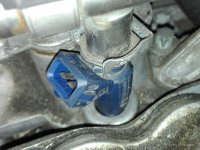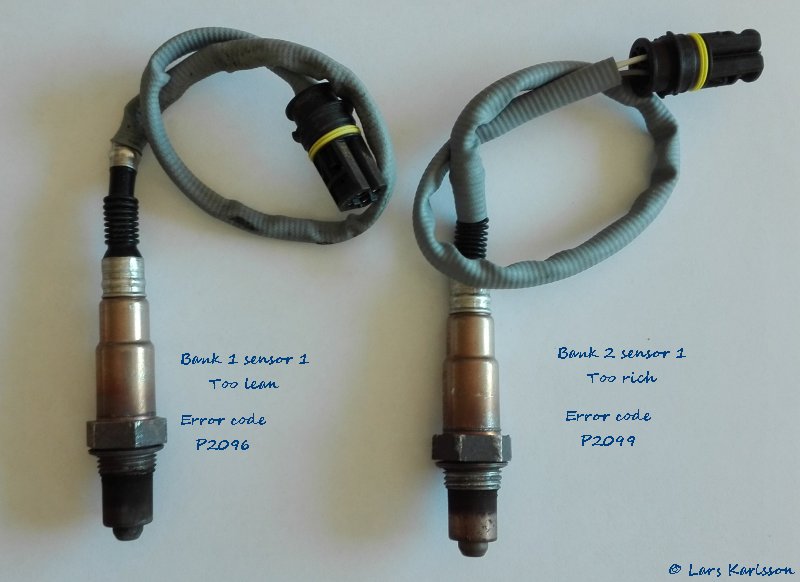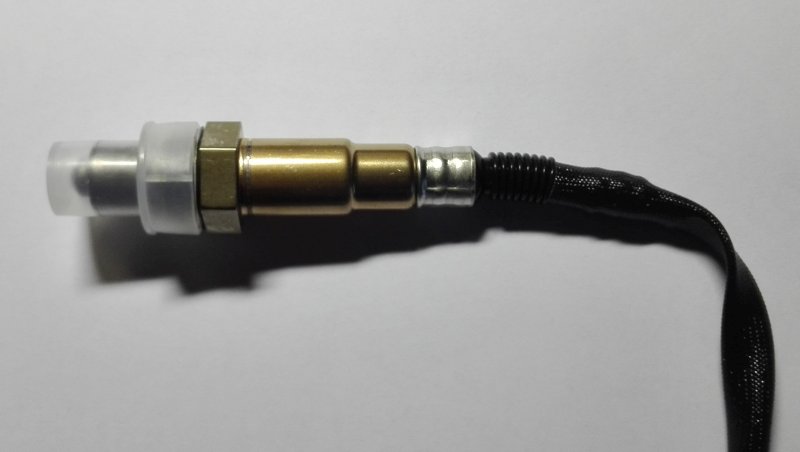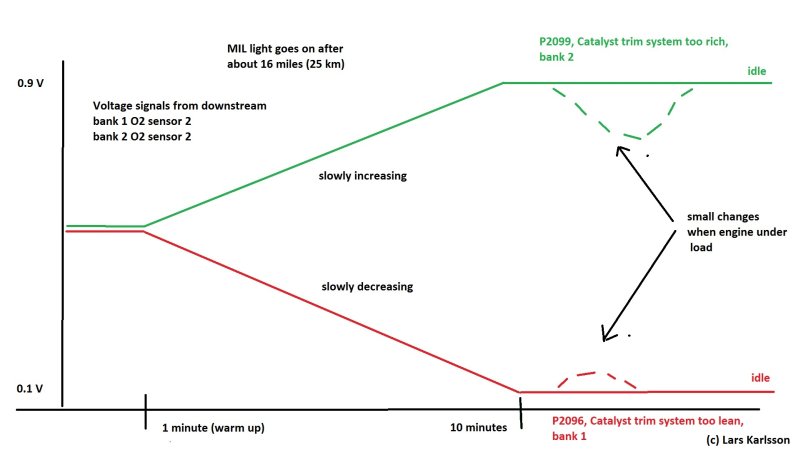|
Advertisement / Annons: |
Chrysler Crossfire
|

|
4, O2 sensors:Now only the O2 sensors (lambda sensors) left that has to be checked or replaced. There are four of them, one upstream and one downstream for each catalyst. Normally you only need to replace the upstream O2 sensors, that's where the exhaust come in from engine and it's very hot here and it give a shorter lifetime. 
Here how the old O2-sensors looks. The lean one has most soot on it, strange. Maybe that show that when sensors show a lean fuel it try to compensate too much. None of them looks very old, I believe an earlier owner has already changed these ones. Note that the threads on the right O2-sensor are damaged, a sloppy mechanic has been on the move. If it leaks here, it interferes with the emission system. Possible one of the reasons I am having MIL lit up. There was no damaged on the threads on the exhaust system so the new O2 sensor fits correctly. I have an overview of the ODB reader and what I used here. When buying new O2 sensor you must have one that fit your car. My Crossfire has a modern O2-sensor with heater element and then it has four wires. Also the length of the cables and the socket can differ. They are not very expensive today, about 60 Euro if you buy them with mounted connector and about 25 Euro without. I have seen sometimes that there are different part numbers on the left and right O2 sensors, not sure why, maybe only the cable length.
Update: Before you buy anything, check carefully that it fits your car! I bought two with 0.5 meters cable length and another two with very long cables without the cable socket. Now when the old ones looks ok I don't want to cut the wires, I must find new cable sockets, no one seems to sell these, maybe it wasn't so wise to buy O2-sensors without sockets. 
The new O2-sensor. If you take the car to a garage they will charged you about 500 Euro to replace one of them. After this I took the car for a test ride. 
Connected the OBD reader and erase the old error code. Here you can see the fuel trim reading. Earlier they was at the range -10% to 0% and that could have caused the MIL alarm. Now +/- 4% and with a mean value of 0%, good! Now the reading looks much better. If there still is some problem the MIL light will lit up after about 25 km. No error yet after 32 km, I will see when I drive it longer if it still works.
Update: 
Here is a schematic drawing what happens with the signals from post O2-sensors. I think bank 2 sensor is working ok, it's just the systems is cheated by the bank 1 sensor that indirect indicate a vacuum leak. Both sensor can sometimes go the full range, 0.1 volt to 0.9 volt and that indicate that the sensors should be ok. A simple test can be done, just create a small vacuum leak. You can open one of the vacuum hose a little bit. Then the O2-sensors will feel that there is too much oxygen, too lean running. The voltage goes down in a few seconds, almost to zero. When stopping the vacuum leak the voltage goes up to the level they had before. This is how the upstream sensors react on a vacuum leak, the downstream sensors could be different depending on the functions of them. To get more information, look at the provided links here. After have Google all the night after information what's wrong I found that there is an O-ring under the throttle body that can go bad after some years and start to leakage. That's next thing to investigate. From the Crossfire forum I got the advice to check the exhaust for air leaks. Our air has about 21% oxygen, the rest is nitrogen. In the exhaust system the oxygen levels are about 0.5 to 3%, so any extra fresh air coming into the system disturb the sensor very much. One big problem for me to find what's wrong are that I don't have any information how the down streams sensors shall behave. Old cars didn't use down stream sensors in the regulation, but this car do. On the internet there are almost always answers of your problem, you just has to know which word you shall search with. This evening I used these words: "voltage graph downstream O2 sensor" and got very useful information. Some of the search results:
This was very great help for me to keep on with my testing. I now see that the behavior of the downstream sensor maybe is ok, and the pulsating graph I had was just because I didn't let the catalytic converter heat up enough, it's not enough to just let the engine idle. I also did a test with the Car Doctor app, here I found the reading of the Long Term Fuel Trim, I didn't have them on the Torque app. Now I see they are totally wrong, -8% and -20%. Very strange because the Short Term Trim values are around 0% in mean value. And the Long Term value should be based on these Short Term values. I have driven the car many miles and then it should have corrected it self. Now I have much more to test and still have to check the exhaust system for leaks. Coming back soon.
|
|